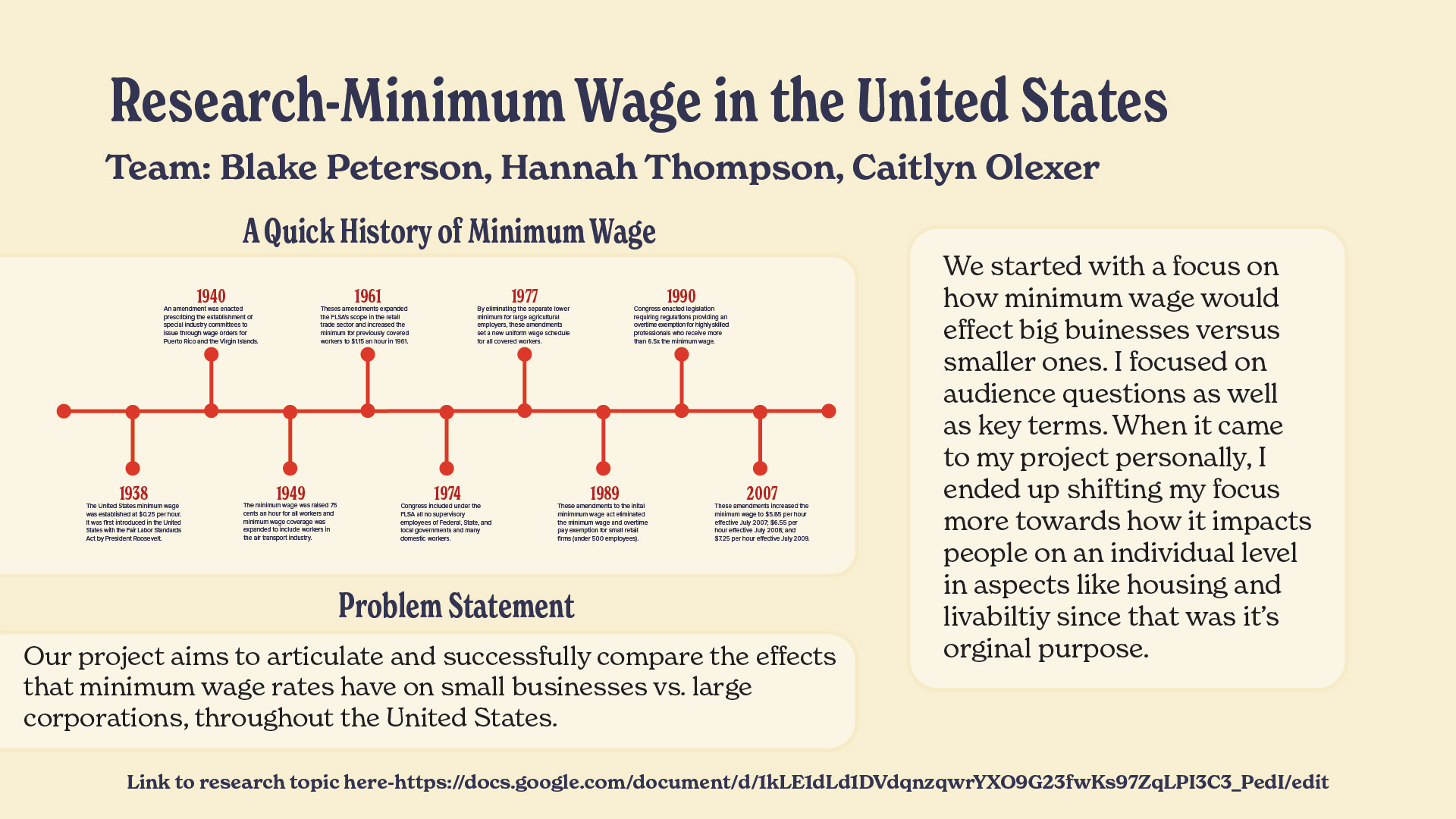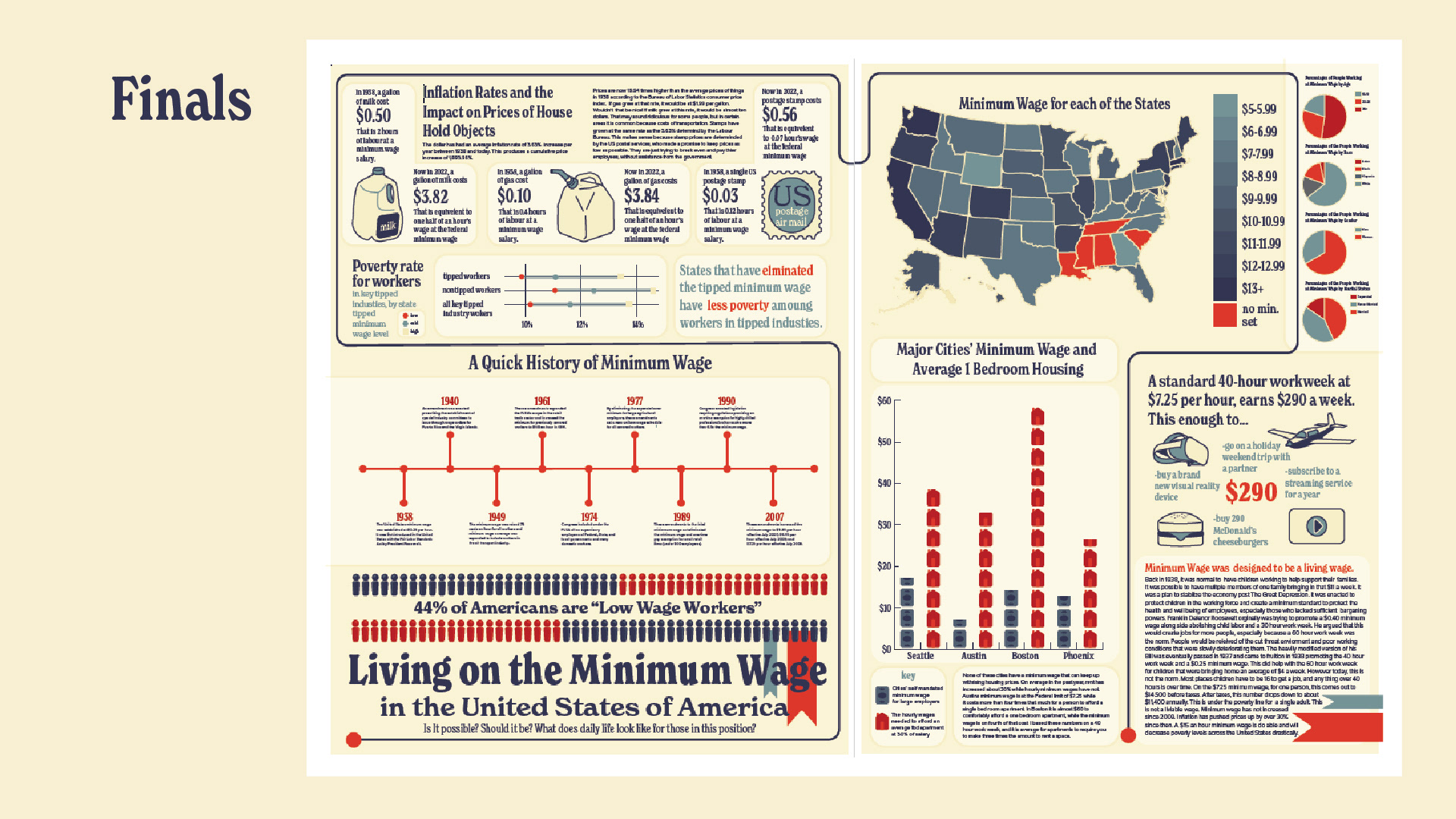Research Deck








Final Boards
Final Video Work
Written Case Study
I wanted to take a closer look at the infographic panels that I made about minimum wage in the United States. I was tasked with researching and creating an infographic for a wicked problem. A wicked problem is defined as a social or cultural issue that is deeply complex and difficult to solve due to how interconnected it is with this setting. Any solution has real world constraints, because there are always some positive and negative consequences due to its complexity. For this project, I chose to talk about minimum wage because that is something I care a lot about because it impacts my daily life, and it is something I am familiar with given that I have been working “minimum wage” jobs for the past five years. It is not as just as easy as “raise it” because of the impact on smaller businesses, the ability to keep people the same amount of people employed, as well as prices on goods and services. At the same time, it cannot just stay the same considering the impossible housing market, poverty levels, and general inflation of services and goods without a raise. It is a tough one to sort out.
For this project during the research stage, It was my job to come up with a list of terms with definitions pertaining to the topic as well as gather questions about minimum wage from the audience. During this process I realized not many people knew the history of minimum wage. They did not realize why it was created or what it was originally created for. Many people had the pre convinced notion that it was for high schoolers or college students to work while in school. This is a bit scary honestly! People on this wage not having a full grasp of the history and original purpose do not know about what has been sacrificed on their behalf for our society. They can’t press to make change if they are unaware of how things could be or even need to be changed. In recent times with this economy, we are in, and the issues with lack of laborers and strikes, I thought it would be a good idea to talk about both the history of minimum wage and to share what is can do in this time and age, as well as what it is like to live on it. Given that it seems like not a lot of people are actually aware of any of this.
For my boards I started off with showing how many people are actually working low wage (around minimum wage, this includes those on city bases minimum wages, and minimum wage with pay raises). This is 44% of Americans which comes out to be about 145 million people. This is almost half of the population. I wanted people to know the scope of those being affected by this directly. Everyone is impacted indirectly but I wanted to highlight those who truly feel the effects in every aspect. Next I went on to provide a brief history of minimum wage for some more context. It is not too in-depth so it would not overwhelm the readers right from the start. After that I highlighted the poverty rates for these low wage workers based on tipped and untipped wages. I wanted to show how some places have already started making changes that have decreased poverty rates. One of those ways seems to be eliminating pay changes based on whether or not people are making tips. This one is a bit tricky because some days people have great days with lots of tips but other days they make barely anything. The next topic I touched on was inflation and prices of daily objects. The rates seem to have stayed about the same so I moved onto the next topic to get more insight into the root of the issue.
I moved back into some more context information providing a map with every states minimum wage. I purposefully brought attention to the states with no limit set, even if they do have to pay them the $7.25 federal minimum. However, in hindsight it would have been a better idea to do that to those who have their minimum set lower than the federal minimum wage. Even if the minimum is set lower they are required to pay the federal standard. I also included some demographic information alongside that. It would have been more effective though if I included the same information for general population of the United States. After that I included what someone would make on a 40 hour work week, post taxes. I wanted to put that into perspective for those who make enough money to have that amount as disposable and not as money needed to live daily life. It would be interesting to also include a weekly budget of necessities along side that to compare to.
Then I return back to trying to find the root of the problem. This is where things get a bit more interesting. I created a graph that compared some big cities’ minimum wage with how much is needed to afford an average 1 bedroom apartment at the standard a person makes three times the rent to comfortably afford it. I made sure to include a variety of places from around the United States to get the most diverse information. None of these values came out close. The wages to afford housing were all at least double the minimum wages. This was more what I was looking to see but I felt it was necessary to include the other things so people would be able to see where the issues where coming from so they did not have a preconceived bias as to what was making this wicked problem worse. It was all context building up to the issue. And in the end these are just a hint of what is making up the problem. I could do an endless amount of these panels on the wicked problem of minimum wage, poverty, and the housing crisis in the United States. I concluded the panels with another bit more history on minimum wage. I wanted to show people that it originally was something that was designed to be livable. President Roosevelt wanted it to be ten cents higher and cut the average work week down to only thirty hours. It was supposed to be able to pay for schooling, housing, necessities, raising children, and more! I want to raise awareness to this because it can barely do any of those now unfortunately.
I feel like in the end I could have gone more in-depth on almost all of my subjects, but in the end, I was able to create something that would educate people on the topic of minimum wage. I learned a lot about it and where the true issues arose and what needs to be fixed to make things better for everyone. There is still more that I could learn about all of this and more things I could share if I wanted to continue on this topic, but I was able to create a great introduction that is easy to read, clearly organized and nice to look at.